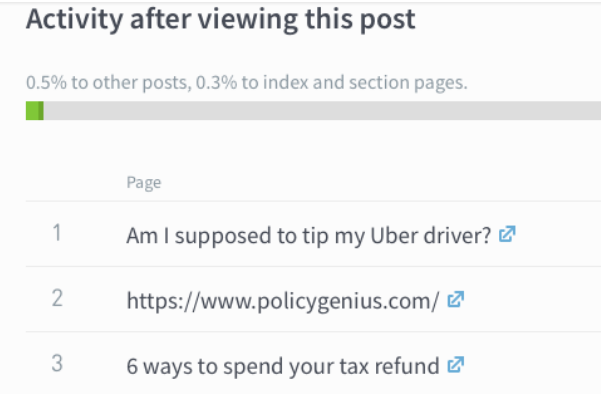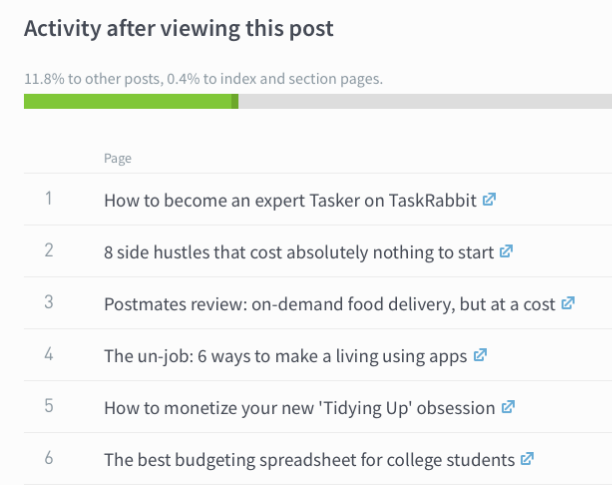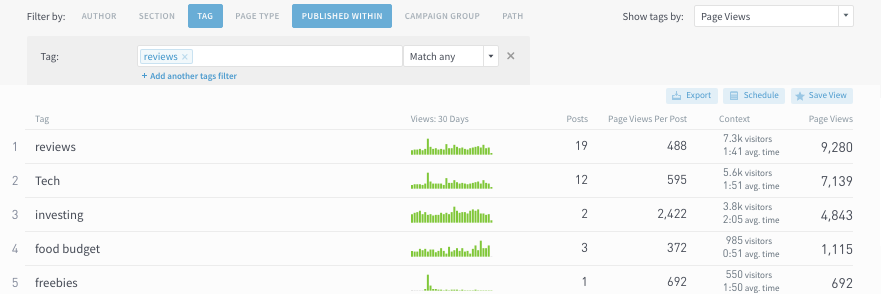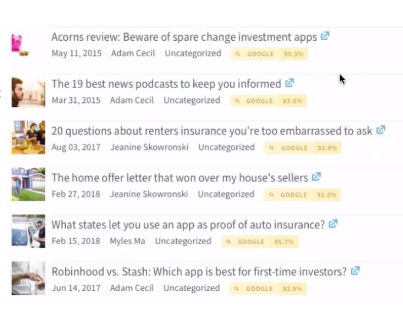Refreshing advice: how Policygenius used organic search to boost on-site recirculation by 300%

This post was adapted from a webinar with Hanna Horvath. Get the rest of Horvath’s tips here.
Staff reporter Hanna Horvath, of Policygenius, knew that her readers are typically people in their thirties and forties, going through major life changes like getting married, having kids, buying homes, and navigating the unfamiliar financial responsibilities that go with them.
Knowing that its core reader is not unlike the demographic of Policygenius’s customers, Horvath needed to clarify the question: who is Policygenius writing for? So she developed a strategy focused on the kind of information readers seek organically when they begin a new financial chapter of their lives. Not only did she pinpoint exactly who their readers were, she identified immediate actions for her team to take and proved the incredible value of their blog’s financial advice: Policygenius increased its on-site recirculation by almost 300%.
Reader intent: ‘What is the purpose of this piece and why is it relevant?’
Horvath spearheaded a project to increase organic traffic and on-site recirculation (that is, views from readers already on-site) without having to produce much new content. Horvath found that by asking herself a few key questions, she could predict the success of the articles before hitting ‘publish.’
“When I’m thinking of our present and future content, I ask, ‘What is the purpose of this article? Is it going to rank and get organic traffic? Is it for the newsletter? Will a syndicate partner pick it up, or is it just a great piece of financial content that would just live on our site and we can link to it?’”
This kind of segmentation is important. A new visitor starting from scratch with a Google search likely needs very different financial advice than the reader already subscribed to the Policygenius newsletter. Knowing the types of information people seek organically also informs Policygenius on how they target new audiences.
How internal linking boosted SEO and reduced bounce rates
Horvath set out to determine which articles from their archive were still driving traffic from search but weren’t doing much else. She noticed 30 articles that stood out to her through Parse.ly — they ranked well in search traffic, but most people left (or “bounced”) immediately after reading.

So she came up with a plan to refresh each of the 30 articles. “Getting an article to rank can be tough,” Horvath said, “so it made more sense for us to work with these articles.” She wanted to increase their organic exposure with the main goal of getting these readers to engage further. In the SEO world, this is known as internal linking–a signal to readers and to Google that Policygenius is the authority on personal finance.
But Horvath didn’t need to link to loads of new content, she just needed to link to the right content.
She created what she called a linking guide: a list of high-quality articles that would be included in any content that ranked high in search referrals. Her team found the list so useful, they made it all searchable in an app.
Updating outdated links and replacing them with new, more relevant ones proved to be a smart move for Policygenius. An analysis, in aggregate, of the 30 refreshed articles from January 19th – March 4th (pre-refresh) compared to March 5th – April 18th (post-refresh) showed:
- The number of visitors to these articles increased 21.5%
- The time they were engaged increased 12.2%
- The average number of visitors who went on to read more went up a whopping 297%

According to Horvath, “This means that more people are coming to these articles, engaging with them, and going on to a new piece of content, which means they were interested and want to read more.”
SEO that scales: a reader-first tagging strategy
As for that linking guide Horvath created? It turned into some important insights that became a resource for everyone.
As the team found it more and more useful, Horvath added tags to each article in the guide, making it easier to search by topic. Starting with just a subset of the content, patterns emerged that developed into a comprehensive tagging strategy that would help Policygenius successfully target and grow specific audiences.
A lot of tags it had used internally were duplicated or simply defunct. That made it hard to track successful content. So Policygenuis gave its tags a refresh too. For readers, this means having access to contextually relevant content–a reader seeking advice about cars sees related auto content, instead of generic financial articles. For Horvath and her team, it means the ability to track and scale Policygenius’ audience immediately and in the long-term.

It quickly became apparent that Policygenius had three specific audiences, each needing unique financial guidance.
- Dedicated readers, those from the newsletter or already on-site, preferred comprehensive financial guides, like those for filing taxes, or buying a car or house.
- Readers from syndication partners liked helpful lists on budgeting and saving. This happened to be content featured in a lot of newsletters as well, a signal that these readers would be more likely to convert into a regular reader.
- Readers from Google tended to be new, and needed more basic how-to advice and reviews, like best personal finance tips or how to stop getting spam calls
“This insight allowed me to come up with a content map to ensure that we were producing content that appealed to our readers and avoiding writing content that wouldn’t resonate,” Horvath said.
The team even got to have a little fun with it. Knowing the kind of content new readers from Google needed helped Policygenius put its best foot forward. An article on “most uninsurable Keanu Reeves characters,” for example, could showcase its expertise in a way that was accessible, informative, and even fun.

Growing your audience doesn’t mean you have to produce exponentially more content, especially when it comes to search. Getting a piece of content to rank high on Google Search isn’t easy. But taking content that’s already driving traffic to your site, and ensuring what you link to is related and relevant is a great way to leverage existing content and establish you as the expert. That’s advice we’re willing to take.
Have some advice you’d like to share? Or in need of some? Email us at pizza@parsely.com
This post was adapted from a webinar with Hanna Horvath. Get the rest of Horvath’s tips here.